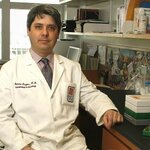Science category landing
Medicine

HOUSTON (April 3, 2009) – A particular nuclear hormone receptor called DAF-12 and molecules called microRNAs in the let-7 family form a molecular switch that encourages cells in the larvae of a model worm to shift to a more developed state, said a consortium led by researchers from Baylor College of Medicine (www.bcm.edu) in a report that appears online today in the journal Science (www.sciencemag.org).
As organisms go through the stages of life, hormones coordinate the changes. Nuclear receptors respond to hormones to coordinate stage transitions, but how they do so is not well understood…

COLUMBUS, Ohio – A new study by Ohio State University cancer researchers shows that boosting the level of a molecule called miR-29b in acute myeloid leukemia (AML) cells can reverse gene changes that trap the cells in an immature, fast growing state of development.
The study discovered how the miR reactivates silenced genes, which enables the leukemic cells to differentiate and mature, important steps that precede their death. The findings suggest that miR-29b could be a potent treatment for AML.
The molecule blocks the action of three enzymes, all of which add small chemical…

Today, during the 87th General Session of the International Association for Dental Research, convening at the Miami Beach Convention Center, a group of scientists from Nihon University (Tokyo, Japan) will present findings suggesting that periodontal disease could act as a risk factor for reactivating latent HIV-1 in affected individuals.
Latently infected cells harbor HIV-1 proviral DNA genomes integrated with heterochromatins, allowing for the persistence of transcriptionally silent proviruses. Hypoacetylation of histone proteins by histone deacetylases (HDACs) is primarily involved in the…

Human embryonic stem cells (hESC) provide a potentially unlimited source of oral mucosal tissues that may revolutionize the treatment of oral diseases. When fully exploited in the future, this source of cells will be able to produce functional tissues to treat a broad variety of oral diseases. However, little is known about how hESC can be developed into complex, multilayer oral tissues that line the gums, cheeks, lips, and other intra-oral sites. However, the use of hES cells for oral application faces numerous obstacles that must be overcome before their therapeutic potential can be…

OAK RIDGE, Tenn., April 3, 2009 -- By identifying a novel compound that primes a plant's immune system, researchers at Oak Ridge National Laboratory and the University of Chicago may be on a path to developing disease-resistant plants.
In a paper published in Science, a team that includes Tim Tschaplinski of the Department of Energy's ORNL reports that azelaic acid has a role in priming the immunity response in Arabidopsis, a small flowering plant related to cabbage and mustard. This plant, commonly known as thale cress or mouse-ear cress, is widely used as a model organism for studying…

A team of researchers from the Massachusetts General Hospital Center for Engineering in Medicine (MGH-CEM) has found the first evidence of cell-to-cell communication by amino acids, the building blocks of proteins, rather than by known protein signaling agents such as growth factors or cytokines. Their report will appear in an upcoming issue of the FASEB Journal and has been released online.
"We were taken by complete surprise," says Rohit Jindal, PhD, a postdoctoral fellow at MGH-CEM and the paper's lead author. "Past reports have implicated various growth factors and the extracellular…

New Rochelle, NY, April 3, 2009—A novel technique for carrying out gene-expression profiling is set to challenge the market dominance of the current, widely used methodology, reports Genetic Engineering & Biotechnology News (GEN). Some scientists believe that digital gene-expression profiling, a fully quantitative approach for gene-expression analysis, will eventually rival microarrays in this application area, according to the April 1 issue of GEN (http://www.genengnews.com/articles/chitem.aspx?aid=2844).
"Digital gene expression technologies are certainly catching the attention of the…

Ask a simple question, get a simple answer: When Abraham Lincoln was asked how long a man's legs should be, he absurdly replied, "Long enough to reach the ground." Now, by using a new microscopy technique to watch the growth of individual neurons in the microscopic roundworm Caenorhabditis elegans, Rockefeller University researchers are turning another deceptively simple question on its head. They asked, "How long should a worm's neurons be?" And the worms fired back, "Long enough to reach their targets."
The researchers' surprising result: Rather than growing like the branches of a tree —…

LIVERMORE, Calif. -- By using the amount of carbon 14 in the atmosphere from above-ground nuclear testing in the 1950s and 1960, researchers have determined that cells in the human heart develop into adulthood.
But as humans age, the percentage of new heart cells decreases markedly. By age 25, renewal of heart cells gradually decrease from 1 percent turning over annually to .45 percent by the age of 75. About 50 percent of the heart cells a human is born with will regenerate during a lifetime.
Myocardial damage often results in chronic heart failure because of the loss and insufficient…

Since the days of Charles Darwin, researchers are interested in reconstructing the "Tree of Life", and in understanding the development of animal and plant species during their evolutionary history. In the case of vertebrates, this research has already come quite a long way. But there is still much debate about the relationships between the animal groups that made their apparation very early in evolutionary history, probably in the late Precambrian, some 650� million years ago. An international research group led by LMU Munich Geobiology Professor Gert Wörheide and colleagues from France and…